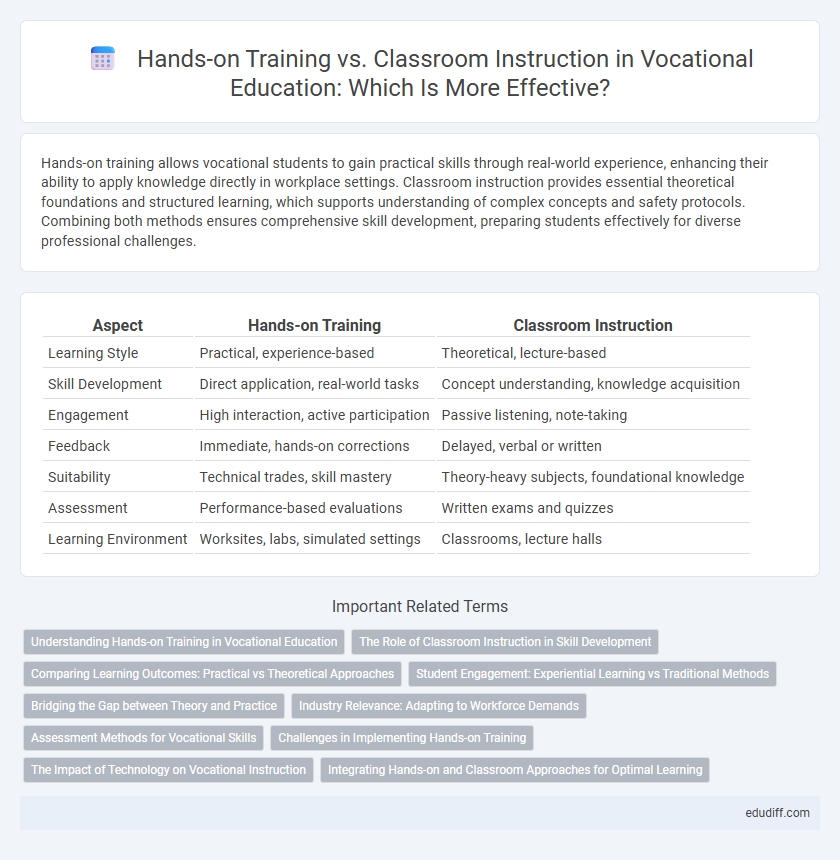Hands-on training allows vocational students to gain practical skills through real-world experience, enhancing their ability to apply knowledge directly in workplace settings. Classroom instruction provides essential theoretical foundations and structured learning, which supports understanding of complex concepts and safety protocols. Combining both methods ensures comprehensive skill development, preparing students effectively for diverse professional challenges.
Table of Comparison
| Aspect | Hands-on Training | Classroom Instruction |
|---|---|---|
| Learning Style | Practical, experience-based | Theoretical, lecture-based |
| Skill Development | Direct application, real-world tasks | Concept understanding, knowledge acquisition |
| Engagement | High interaction, active participation | Passive listening, note-taking |
| Feedback | Immediate, hands-on corrections | Delayed, verbal or written |
| Suitability | Technical trades, skill mastery | Theory-heavy subjects, foundational knowledge |
| Assessment | Performance-based evaluations | Written exams and quizzes |
| Learning Environment | Worksites, labs, simulated settings | Classrooms, lecture halls |
Understanding Hands-on Training in Vocational Education
Hands-on training in vocational education immerses students in real-world tasks, enhancing skill acquisition through practical experience. This method improves retention and job readiness by allowing learners to apply theoretical knowledge directly to tools and equipment used in their trade. Research shows that hands-on training boosts problem-solving abilities and confidence, preparing students more effectively for the demands of the workforce compared to traditional classroom instruction.
The Role of Classroom Instruction in Skill Development
Classroom instruction establishes a foundational understanding of vocational concepts and theory, which enhances the effectiveness of hands-on training by providing learners with essential knowledge frameworks. Structured lessons allow for systematic skill development through guided practice, feedback, and peer collaboration, fostering critical thinking and problem-solving abilities. This approach ensures that learners acquire both cognitive skills and technical proficiency necessary for real-world vocational applications.
Comparing Learning Outcomes: Practical vs Theoretical Approaches
Hands-on training enhances skill retention and job readiness by engaging learners in real-world tasks, fostering problem-solving and critical thinking essential for vocational success. Classroom instruction provides a solid theoretical foundation, enabling learners to understand principles and concepts that guide practical applications. Combining both approaches yields the best outcomes, integrating knowledge comprehension with experiential learning for comprehensive vocational competence.
Student Engagement: Experiential Learning vs Traditional Methods
Hands-on training significantly enhances student engagement by immersing learners in real-world tasks, fostering experiential learning that boosts skill retention and problem-solving abilities. In contrast, classroom instruction relies heavily on traditional methods like lectures and note-taking, which may limit active participation and practical application. Vocational education benefits from integrating hands-on experiences to optimize learning outcomes and better prepare students for workforce demands.
Bridging the Gap between Theory and Practice
Hands-on training bridges the gap between theory and practice by immersing learners in real-world scenarios that enhance skill retention and application. Classroom instruction provides foundational knowledge and structured frameworks essential for understanding complex concepts. Combining both methods ensures vocational students develop practical competencies alongside theoretical insights, optimizing workforce readiness.
Industry Relevance: Adapting to Workforce Demands
Hands-on training enhances industry relevance by providing practical skills directly aligned with workforce demands, ensuring students gain real-world experience in vocational settings. Classroom instruction offers foundational knowledge and theoretical concepts necessary for understanding industry standards but may lack immediate application. Combining both methods maximizes adaptability to evolving job market requirements, equipping learners with comprehensive expertise relevant to current vocational trends.
Assessment Methods for Vocational Skills
Assessment methods for vocational skills in hands-on training prioritize practical evaluations such as performance tasks, simulations, and real-world project completions that directly measure competency levels. Classroom instruction typically relies on written tests, quizzes, and theoretical exams to assess knowledge retention and understanding of vocational concepts. Combining both approaches offers a comprehensive evaluation framework that ensures mastery of both practical application and foundational theory.
Challenges in Implementing Hands-on Training
Hands-on training in vocational education presents challenges such as high costs for equipment and materials, limited availability of qualified instructors, and safety concerns when students operate machinery or tools. Managing individualized instruction in practical settings demands significant time and resources, complicating scalability compared to traditional classroom methods. Balancing hands-on practice with theoretical knowledge requires structured curriculum design and continuous assessment to ensure skill proficiency.
The Impact of Technology on Vocational Instruction
Technology has revolutionized vocational instruction by enabling immersive hands-on training through virtual simulations and augmented reality tools, enhancing skill acquisition beyond traditional classroom methods. Online platforms and adaptive learning systems allow personalized instruction, catering to individual learning paces while providing real-time feedback often missing in conventional settings. The integration of digital tools fosters greater engagement, practical experience, and accessibility, ultimately bridging the gap between theoretical knowledge and applied vocational skills.
Integrating Hands-on and Classroom Approaches for Optimal Learning
Integrating hands-on training with classroom instruction enhances vocational education by combining practical skills development with theoretical knowledge. This blended approach improves retention and application of concepts, fostering a deeper understanding of industry practices. Vocational programs that balance experiential learning and structured teaching achieve optimal student engagement and job readiness.
Hands-on Training vs Classroom Instruction Infographic

 edudiff.com
edudiff.com